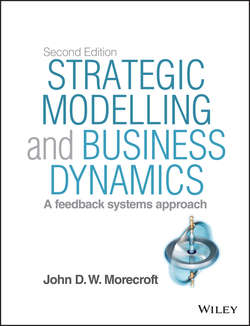Читать книгу Strategic Modelling and Business Dynamics - Morecroft John D. - Страница 9
На сайте Литреса книга снята с продажи.
Preface from the First Edition 3
Manufacturing Dynamics and Information Networks
ОглавлениеThe first phase coincided with my doctoral dissertation at MIT when I worked on manufacturing and supply chain dynamics in Cummins Engine Company and Harley-Davidson. I was fortunate, back then, to have Jay Forrester as my PhD thesis supervisor, Jim Lyneis as a collaborator/faculty adviser on the Cummins project, and Nathaniel Mass as a faculty instructor. I learned many valuable modelling skills from them and from MIT's intensive academic apprenticeship with its special educational blend of theory and real-world practice. I still remember the sense of excitement as a first-year doctoral student, arriving by plane in Columbus Indiana, headquarters of Cummins Engine Company. There, I worked on the Cummins manufacturing dynamics project and found myself applying the inventory control, forecasting and production planning formulations I had learned at MIT. The simple factory model in Chapter 5 contains echoes of these same formulations. Further archive material on manufacturing dynamics can be found in the learning support folder for Chapter 5 on the Learners' website (see the About the Website Resources section).
My doctoral thesis topic arose from an on-the-job discovery that circumstance presented. I was working simultaneously on manufacturing models of Cummins and Harley-Davidson. When I set out the 10–15 page diagrams of these two models side-by-side on my apartment floor in Cambridge (Massachusetts), I noticed that the information flows which coordinated multi-stage production in the two factories were arranged in different patterns. Every stage of production in Harley, from final assembly of motorcycles to sub-assemblies and raw materials, was coordinated from a master schedule – a kind of top-down control. There was no such master schedule in Cummins's factory at the time. Stages of production followed local order-point rules. It turned out that Harley-Davidson was operating a computer-driven top-down material requirements planning (MRP) system, which was entirely new to manufacturing firms at the time (and, back then, had scarcely featured in the academic literature on operations management). My thesis compared the long-term dynamic performance of these alternative approaches to production planning and control. A striking result was that traditional order-point rules outperformed MRP (in terms of operating cost, production stability, inventory availability and lead-time predictability). Only under special and hard-to-achieve factory conditions was MRP superior, despite the cost-savings touted by advocates of MRP. And so my curiosity about information networks began.
As an aside, I should mention that the basis for the manufacturing models in my thesis was the production sector of the MIT group's National Economic Model. The production sector was essentially a generic model of the firm, residing within a system dynamics model of the US economy. The premise of the group's research at the time was that the US economy could be conceived as a micro-economic collection of interacting firms, households and banks. Macro-economic behaviour arises from micro-structure. Jay Forrester was leading the National Model project, so he knew the production sector intimately. As my thesis supervisor he was able to swiftly critique and guide my efforts to adapt this generic model of the firm to fit what I had discovered from the company-specific models of Cummins and Harley. I learned a great deal about model formulation and behaviour analysis from those encounters. I also learned from other doctoral students in system dynamics who, at the time, included David Andersen, Alan Graham, Mats Lindquist, Ali Mashayeki, George Richardson, Barry Richmond, Khalid Saeed and Peter Senge; and then later Nathan Forrester, John Sterman, Jack Homer, Jim Hines and Bob Eberlein.
It was while working with the production sector, which was a visually complex model, that I took to drawing boundaries around sets of model symbols that belonged with a given policy function, such as capacity utilisation or scheduling and ordering. This visual simplification procedure later led to policy structure diagrams as a high-level way of representing the coordinating network in system dynamics models. I use both policy boundaries and policy structure diagrams throughout the book.
